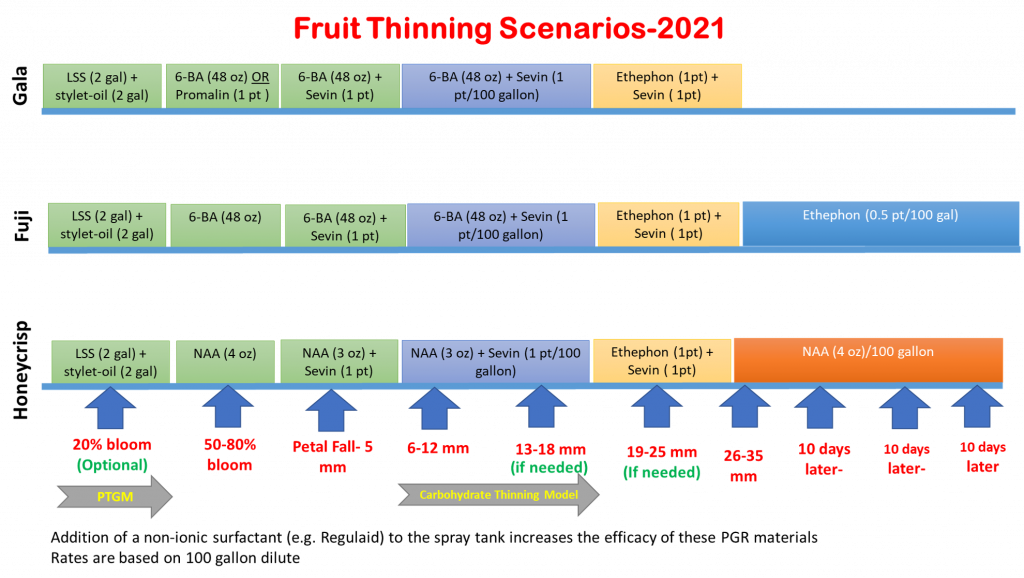


Greetings:
Please see below the updates from Dr. Srdjan Acimovic on the fire blight situation in Virginia.
If the data from Roanoke International Airport station are correct there will be fire blight infection today 4/14 triggered by the rain, in and near Roanoke. Growers should apply strep 1.5 lb + Regulaid 1 pt/100 before rain or apply this mix up to 24 h after the rain event that triggered the infection. What puzzles me is that Floyd (CLH), not so far away from Roanoke, has no infection predicted for 4/14, leading me to believe that it either one of the two stations is not calibrated properly OR it will be hit or miss in terms of where rain/dew lands. Next, the infection occurred in Esmont (Rees), Lynchburg, and Red Hill yesterday 3/13 and if the growers did not apply streptomycin before the rain/dew on 3/13 triggering the infection, they must and can still apply strep 1.5 lb + Regulaid 1 pt/100 today i.e, up to 24 h after the rain event that triggered the infection for it to be effective. In Lynchburg infection is also predicted today 4/14 and the spray today 4/14 will cover for both infections 4/13 and 4/14. In Richmond, if the station is plugging in the correct weather data into the model, there was contiguous infection 4/9-12 which is not good, and proper response as per my previous blog was to spray on 4/10, and 4/12 to cover for all 4 infections and both times growers should have applied strep 1.5 lb + Regulaid 1 pt/100 to get 24 h kick-back and thus cover for all 4 infections. This is based on my experiences from eastern NY and is different from the VA spray guidelines that currently state that a streptomycin application remains effective 3-5 days. Based on this experience with the outbreaks I saw after similar block of infection in NY, I disagree with that 3-5 days as per my blog published here: 1. Frightful Blight Model Cases How Long A Streptomycin Spray Lasts; 2. Major Scab Infection/s Possible 25-30 or 28-29 May All East NY posted on May 25, 2020. In Rustburg (Crown), I would apply strep 1.5 lb + Regulaid 1 pt/100 tomorrow 4/15 if the “High” risk turns into “Infection” for 4/14 in NEWA’s EIP model. Danville has had infections continuously from 4/8-12, assuming correct weather data. Most other weather stations do not indicate a risk from infection, assuming they are functioning properly in collecting the weather data. Please check your closest weather station in NEWA daily, and apply protection according to the EIP model, and make sure it is functioning properly before you can trust the model outputs from it.
You can reach Dr. Acimovic at 517-449-0905

Greetings,
Please find below an email I just received from our new plant pathologist, Dr. Srdjan Acimovic, regarding the fire blight situation in different Virginia locations. Dr. Srdjan will communicate his recommendations directly to you through his blog when he officially starts his job with Virginia Tech by the end of May 2021.
I am not sure are the weather stations accurate i.e. functioning properly in the airports or orchards, but there is a fire blight infection predicted for today and tomorrow in Charlottesville, and there were three fire blight infections in Roanoke on 4/8, 4/9 and today 4/10, and the same is in Lynchburg. I hope the growers are on top of looking the EIP model in NEWA daily during bloom and caught this and already applied on 4/9 streptomycin + Regulaid in Roanoke and Lynchburg. It they did not, I would still recommend to apply this mix today on anything in bloom. In Charlottesville they need to apply streptomycin 17% @ 1.5 lb/A + Regulaid 1 pt/100 gal today or tomorrow (24 h after the infection on 4/10) on anything that is in bloom. As I recommend on my talks earlier in Feb & March, growers should look at the EIP in NEWA daily. In Manassas, fire blight infection is predicted for 4/12, in Rustburg there is an infection today 4/10, and there was an infection block from 4/6-8. I hope they protected against that block. In Staunton there is an infection today 4/10, in Washington (G cellars) there was an infection 4/7. In Newport News there is an infection tomorrow 4/11, In Norfolk there is an infection today 4/10 and 4/11. In Richmond infection occurred yesterday 4/9, and it still warrants an application of strep+ Regulaid today when another infection is predicted also. In Staunton infection is predicted today, they can spray up to 24 h after infection today. Same spray mix recommended above will work.
Now, for all the locations that did not apply streptomycin on time in Roanoke and Lynchburg (for infection 4/8) they should immediately apply 12 oz/100 gal of Apogee or equivalent rare of Kudos, at 2-3 days from the infection on 4/8, and they should still apply streptomycin + Regulaid mix above today or tomorrow for infection today. They can mix all three, Apogee, strep, Regulaid. If no Regulaud accessible use LI700, but Regulaid is preferred.
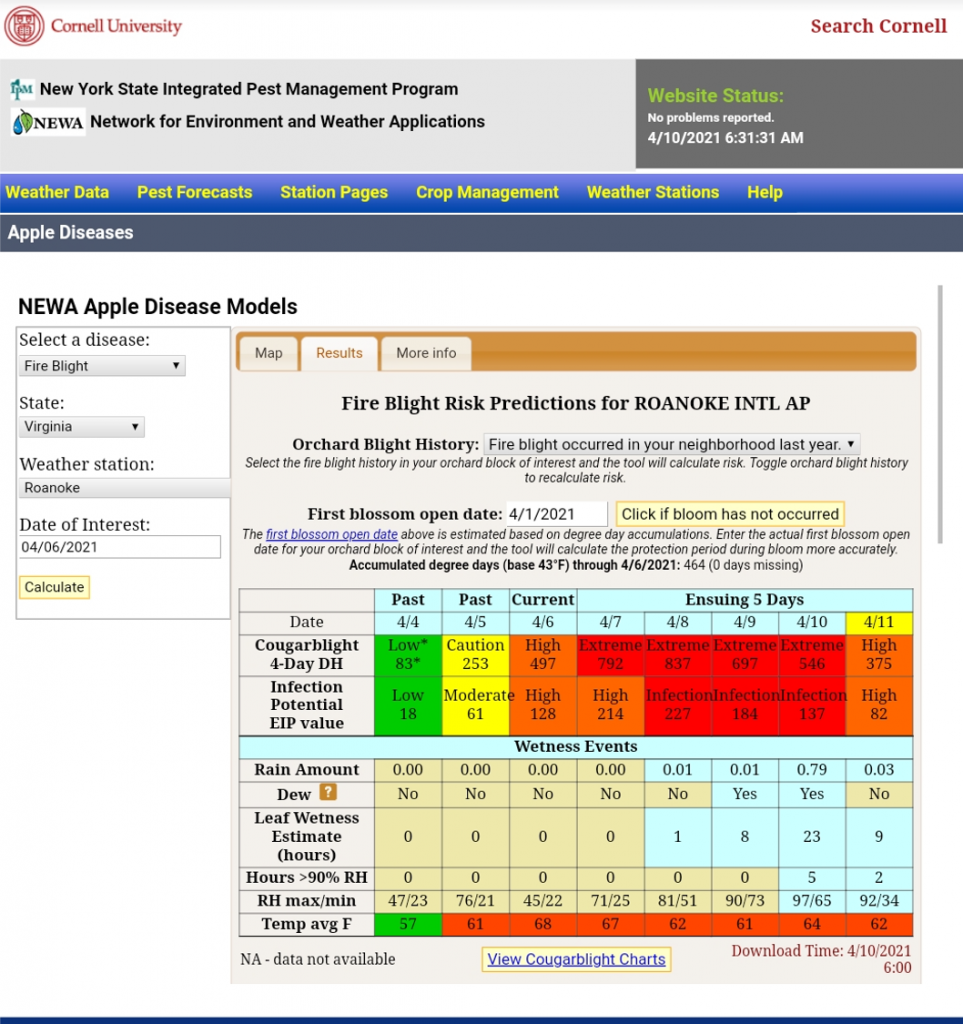

Our digital temperature data loggers placed in four different blocks in the AHS Jr. AREC’s research farm indicated that we were hit by killing freezing temperatures in the mornings of Friday (April 2) and Saturday (April 3), with the latter being more aggressive and long-lasting. In fact, the lowest we received on Friday was 24oF, but on Saturday, our trees were hammered by temps as low as 21oF for more than 30 min. 21 oF for 30 min or more are enough to kill 90% of apple flower buds at ‘tight cluster’, ‘first pink’ and ‘full pink’. Today (April 5), we collected flower clusters from Gala, Fuji, Pink Lady, Red Delicious, Zester, and Honeycrisp. Except for Zester, all the cultivars are only moving from tight cluster to first pink. Zestar with flowers at ‘full pink’ showed 65% mortality. Other cultivars showed 45% (Fuji), 45% (Gala), 42% (Pink Lady), 15% (Red Delicious) and 5% (Honeycrisp). Unsurprisingly, king blossoms showed far more damage than side flowers. As for sweet cherries, we have recorded 93% flower mortality for flower buds at different stages (mostly first white and first bloom). Luckily and -to some extent- unexpectedly, our ‘Sunhigh’ peach flowers showed less than 25% flower despite being at the pink to the first-bloom stage. I have attached some images below to show some examples of frost damages we detected in apples and sweet cherries.
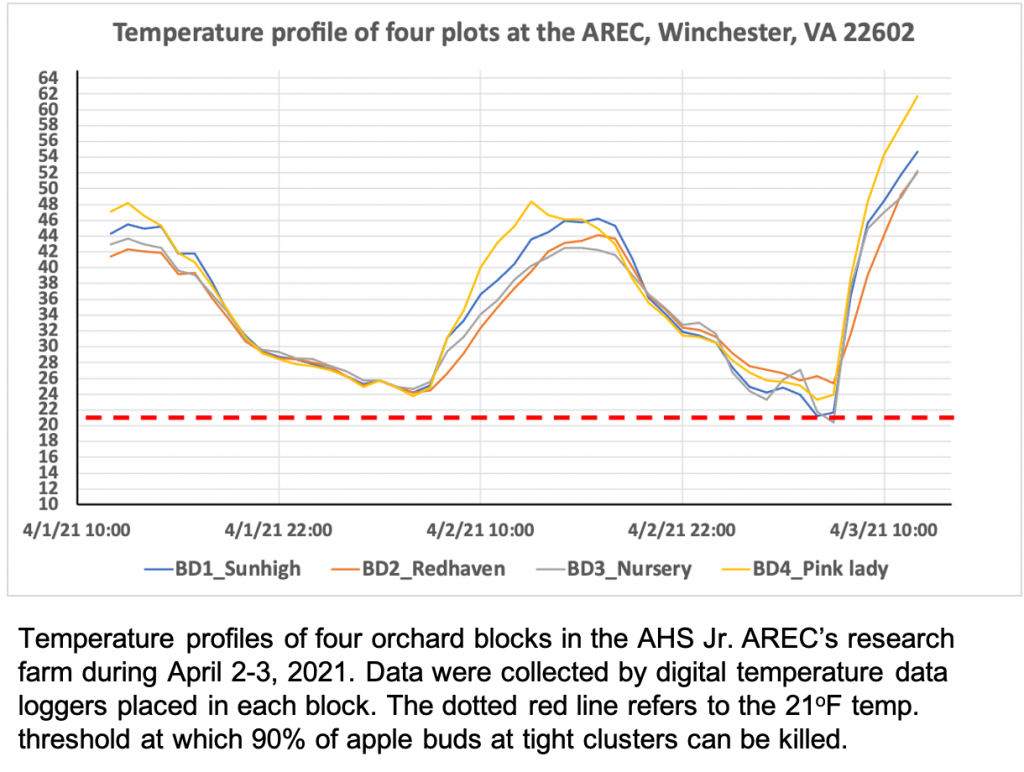
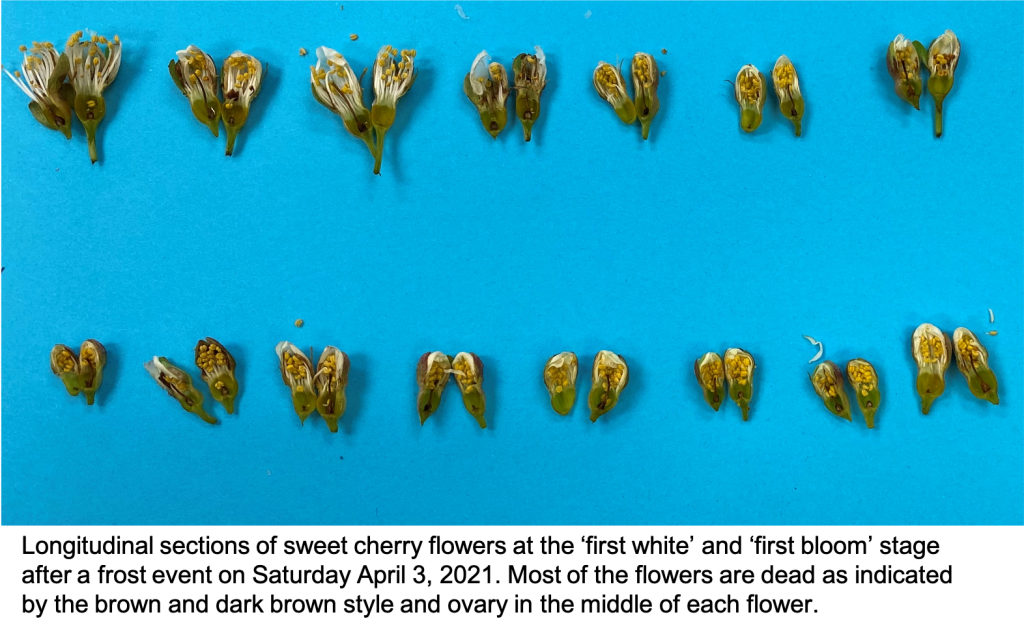
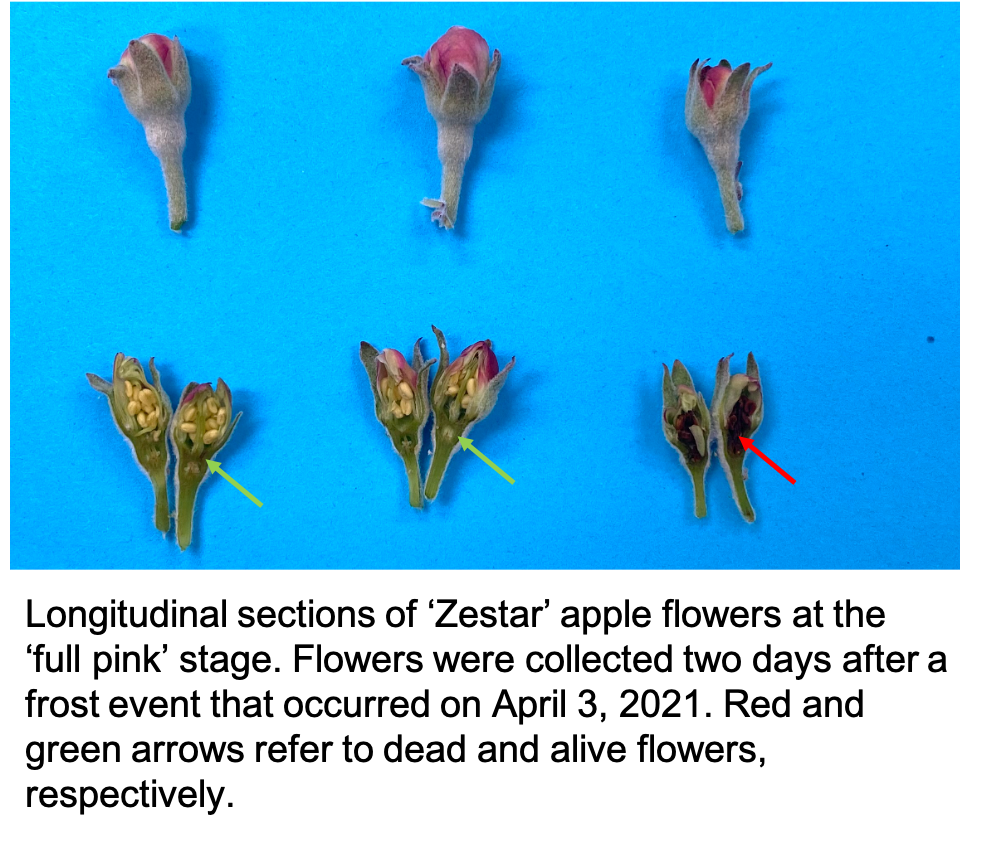
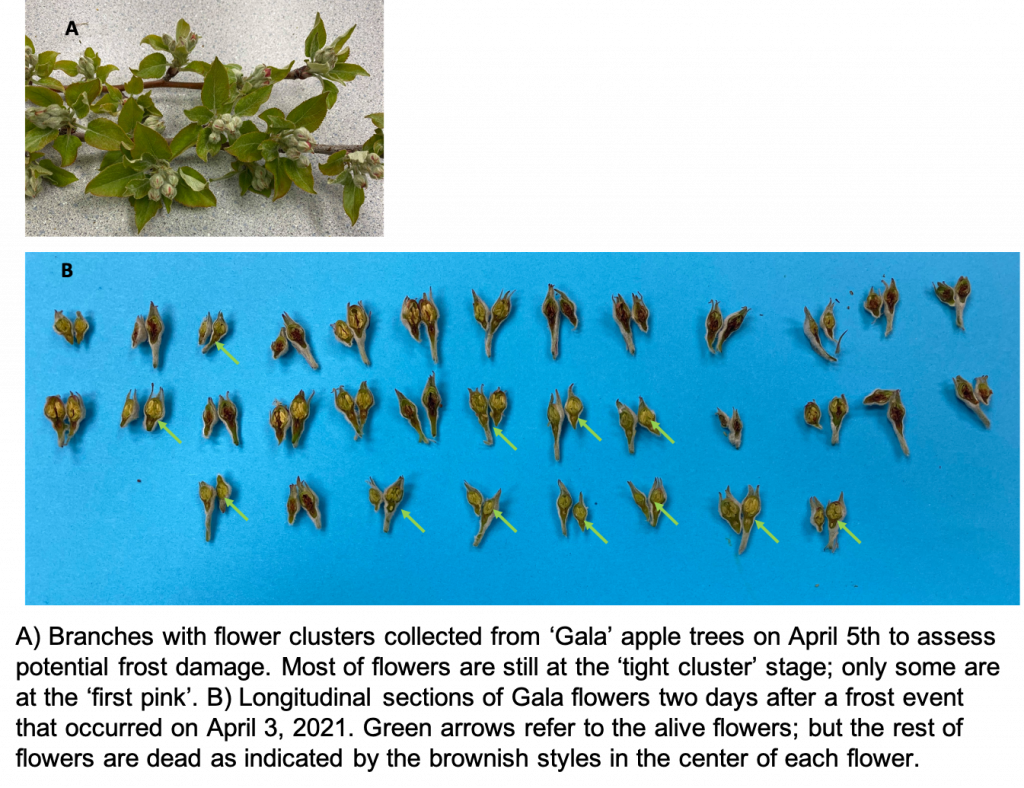

The weather forecasting predicted below freezing temperatures this past Friday (April 2nd) and this morning (Saturday, April 3rd) in the Winchester area (22602). The temperature data as it appears now on the weather network show 2h of 29 oF on Friday morning, 3h at 26 oF and 1h at 25 oF this morning. All these temperatures are above the threshold that causes 90%-kill for flower buds, but can certainly result in 10% damage for apples, sweet cherries, and peaches. To get a better idea of how much damage has occurred after the Friday frost, my research team and I collected flowers from two apple cultivars, a peach cultivar, and a cherry cultivar and evaluated flower viability after 9h of frost (around 3:00 pm, yesterday/Friday). Unfortunately, our data showed 46% and 56% mortality rate in Pink Lady apple and ‘Ebony Pearl’ sweet cherry, respectively. We observed 0% damage in the flowers of ‘Honeycrisp’ apple and ‘Sunhigh’ peach. It’s worth noting that the 46% damage observed in ‘Pink Lady’ flowers is from the King flowers only. We haven’t examined any of the side flowers because they were relatively smaller and hard to observe. It’s also important to know that ‘Pink Lady’ is at the ‘first pink’ stage now, whereas ‘Honeycrisp’, like most of our apple cultivars, are still in the ‘tight cluster’ stage. The majority of our sweet cherry and peach cultivars are at the ‘white bud’ and ‘Pink’ stage, respectively. We will examine these cultivars again tomorrow, Sunday, April 4th, to determine the final percentage of damage after the two frost events. Knowing this information is crucial before starting blossom and fruit thinning. Below are some images to show the extent of frost damage in different species.
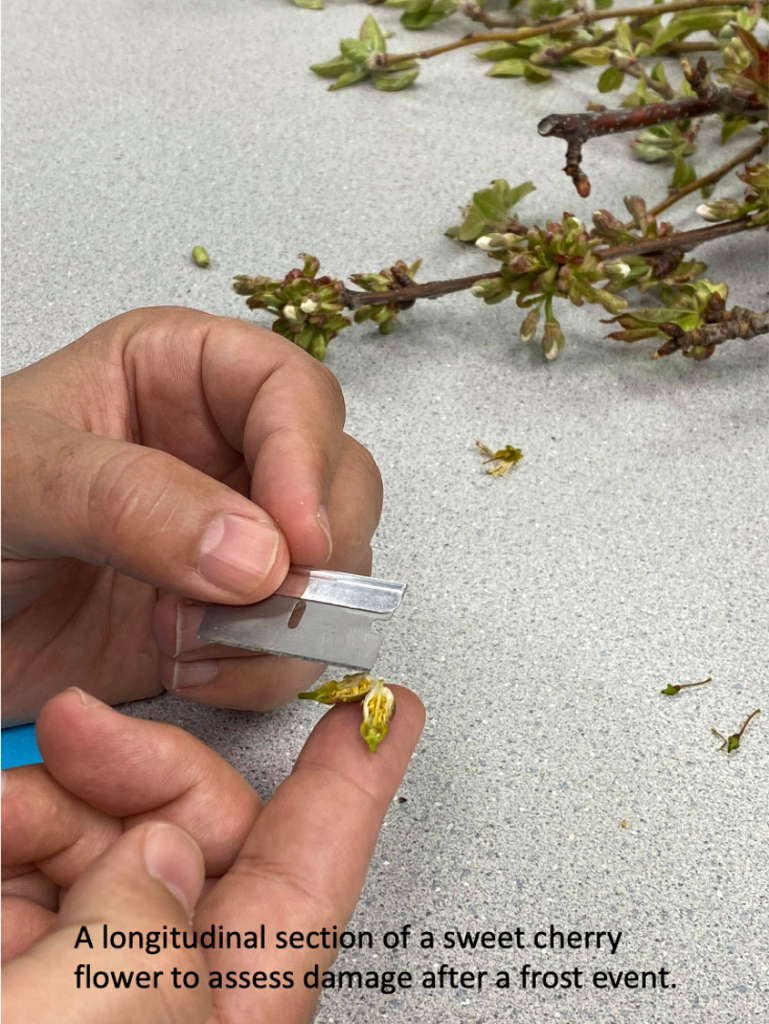
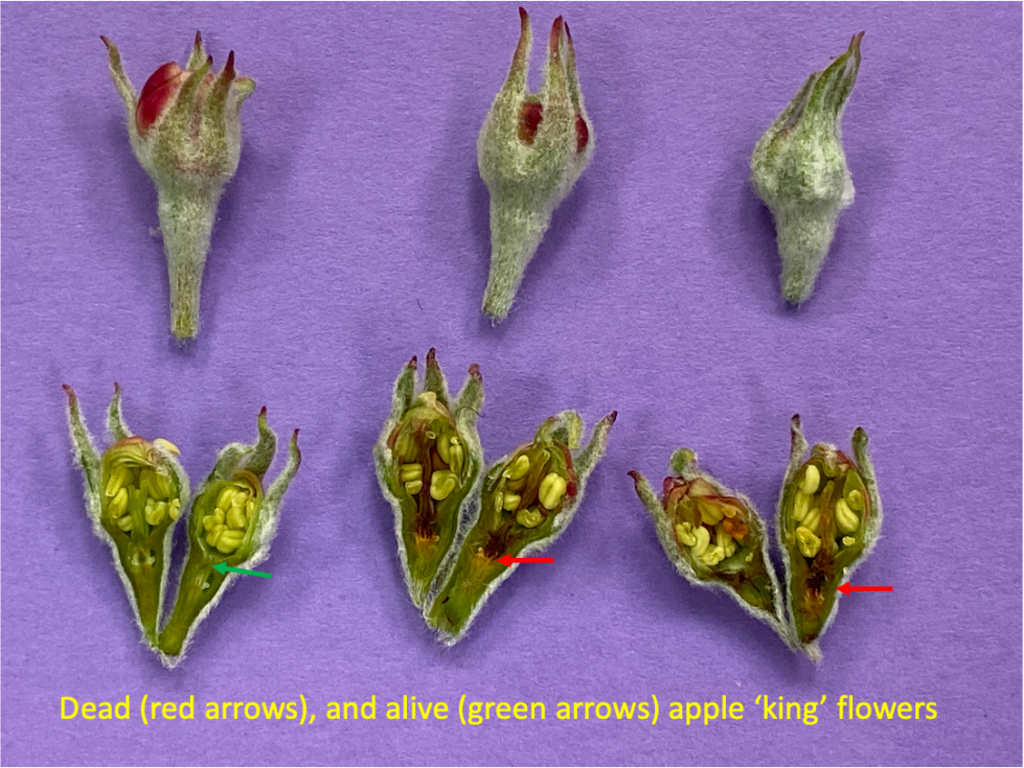
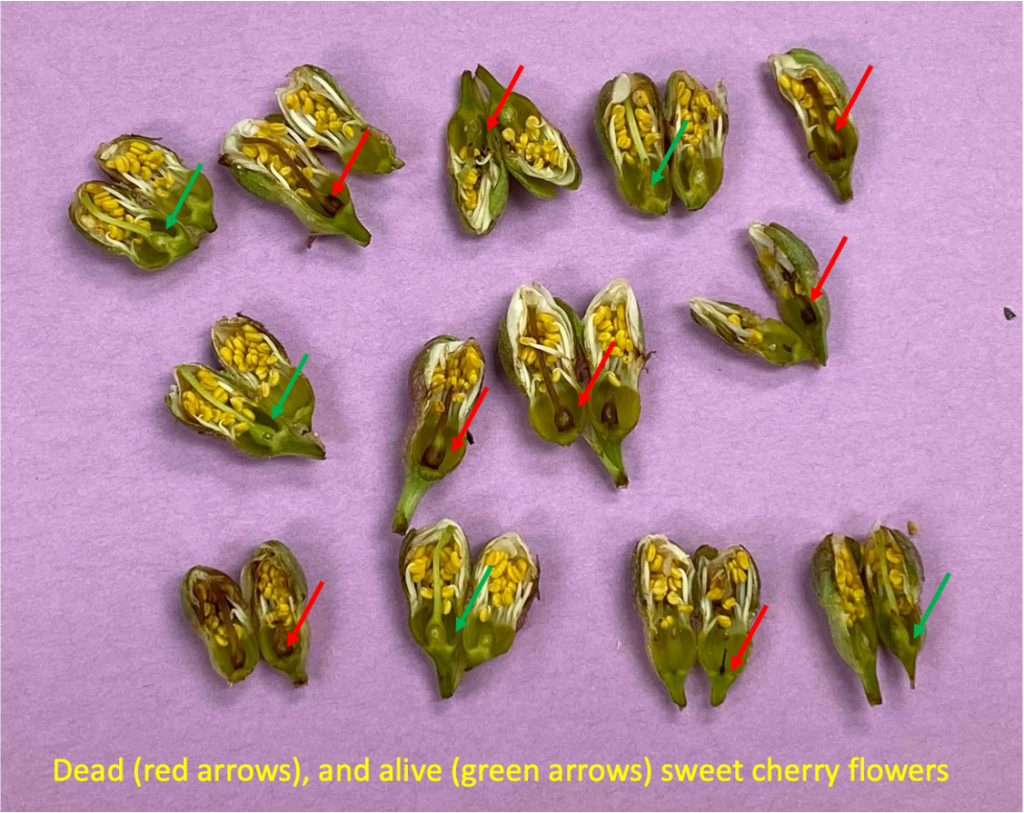
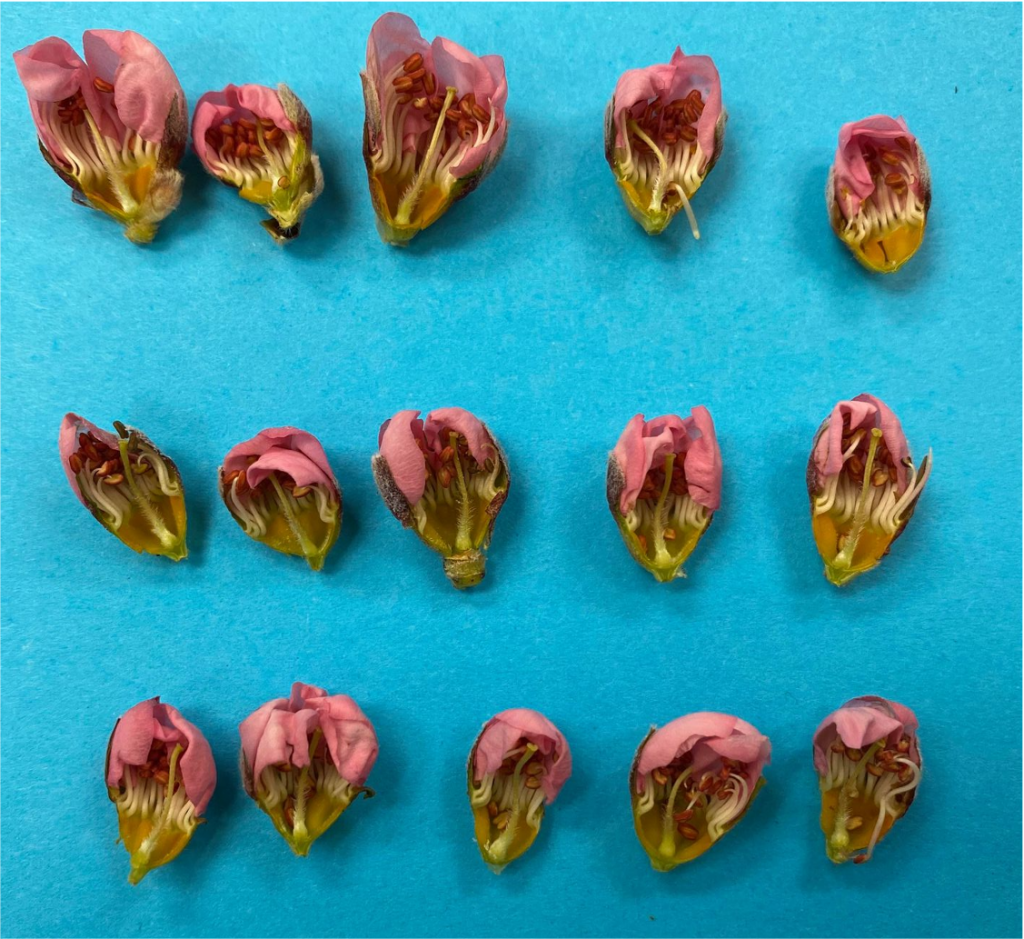

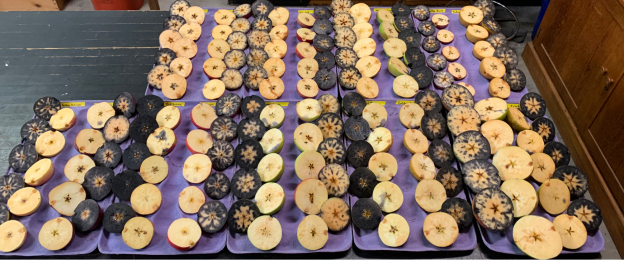
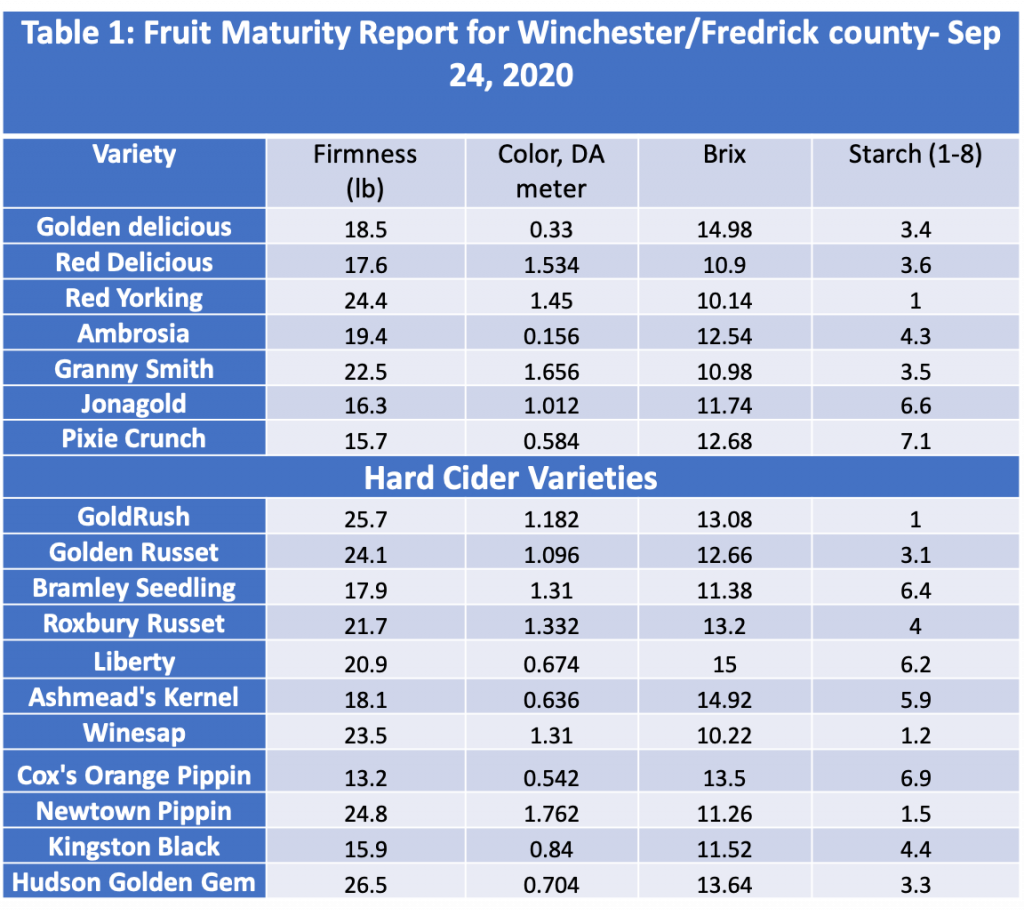
Sherif M. Sherif, Assistant Professor of Horticulture at Virginia Tech, School of Plant and Environmental Sciences, AHS Jr. Agricultural Research and Extension Center
595 Laurel Grove Road, Winchester, VA 22602
Tel. 540-232-6035, Email: ssherif@vt.edu

Sherif M. Sherif, Assistant Professor of Horticulture at Virginia Tech, School of Plant and Environmental Sciences, AHS Jr. Agricultural Research and Extension Center
595 Laurel Grove Road, Winchester, VA 22602
Tel. 540-232-6035, Email: ssherif@vt.edu
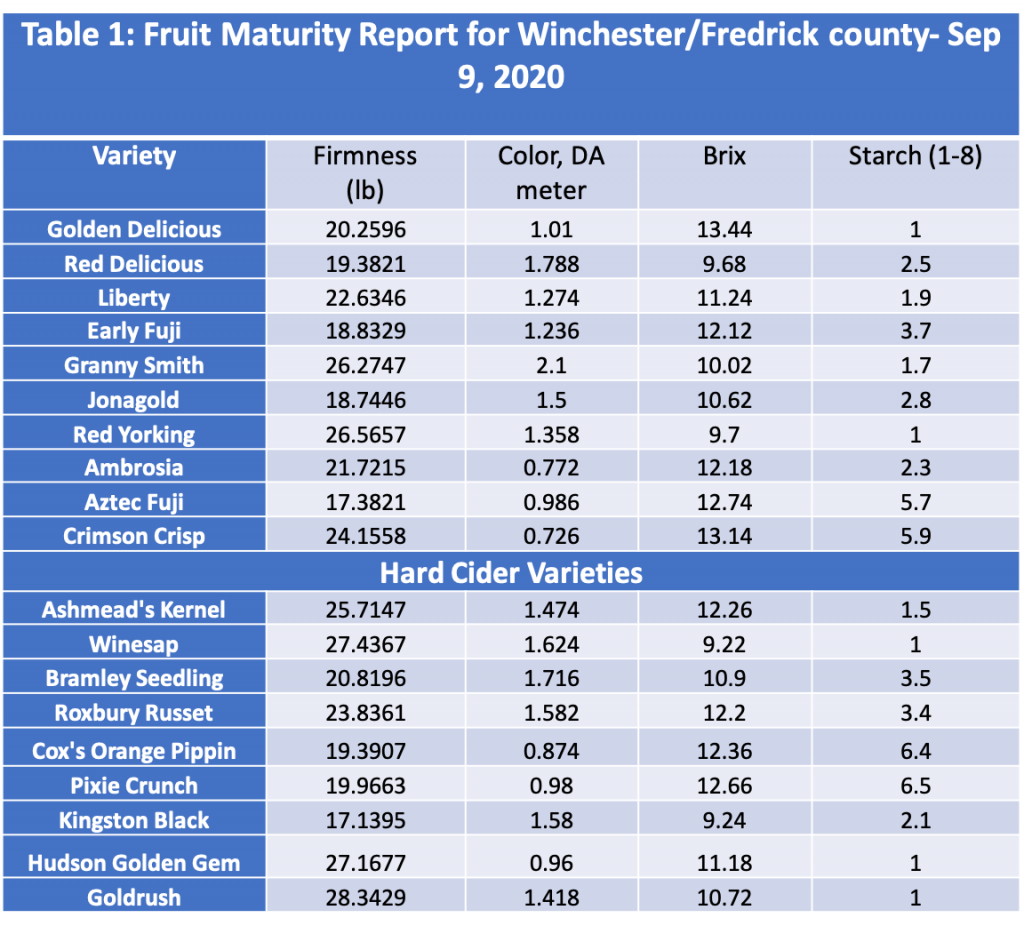
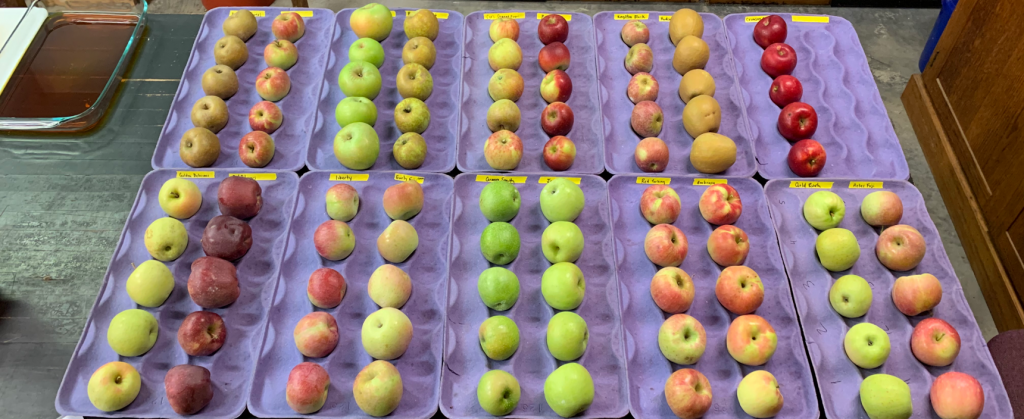
Sherif M. Sherif, Assistant Professor of Horticulture at Virginia Tech, School of Plant and Environmental Sciences, AHS Jr. Agricultural Research and Extension Center
595 Laurel Grove Road, Winchester, VA 22602
Tel. 540-232-6035, Email: ssherif@vt.eduFacebookTwitterEmailShare
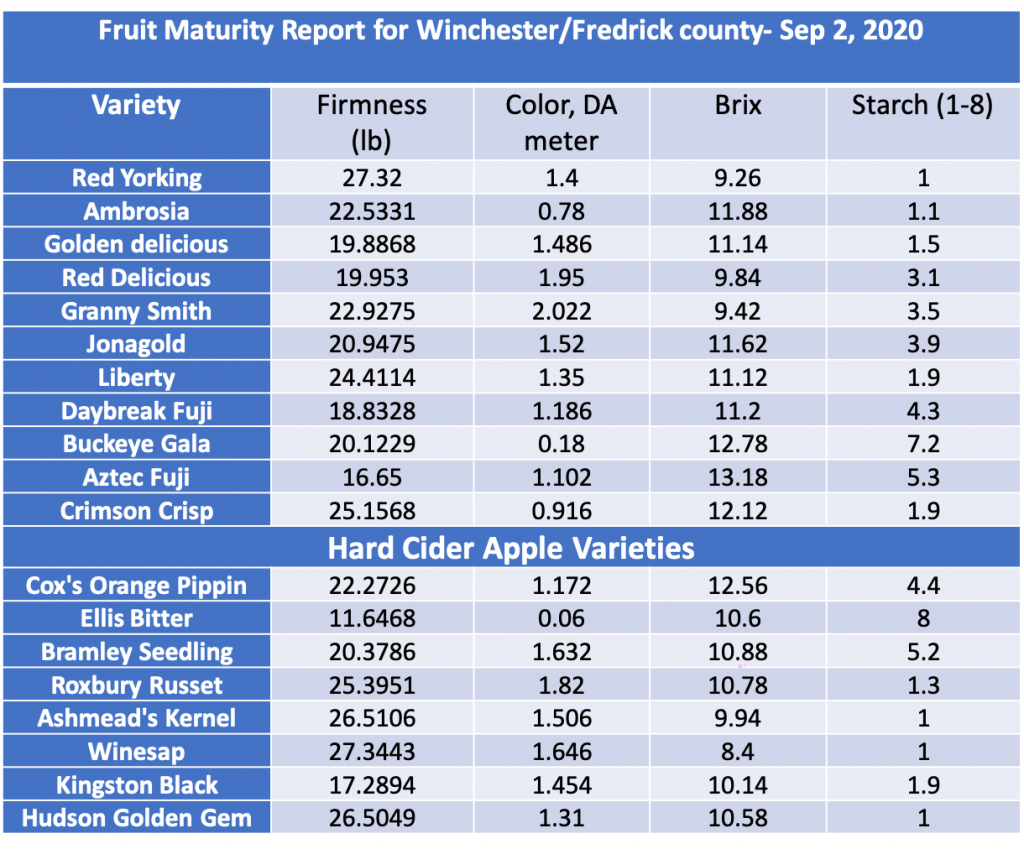
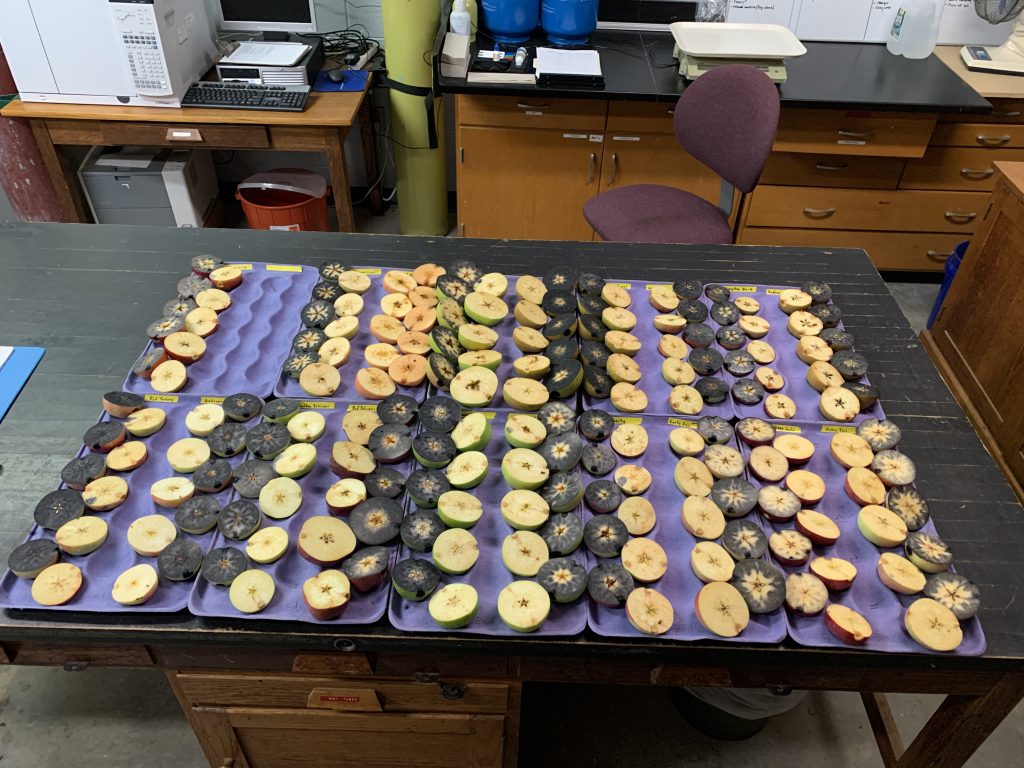
Sherif M. Sherif, Assistant Professor of Horticulture at Virginia Tech, School of Plant and Environmental Sciences, AHS Jr. Agricultural Research and Extension Center
595 Laurel Grove Road, Winchester, VA 22602
Tel. 540-232-6035, Email: ssherif@vt.edu

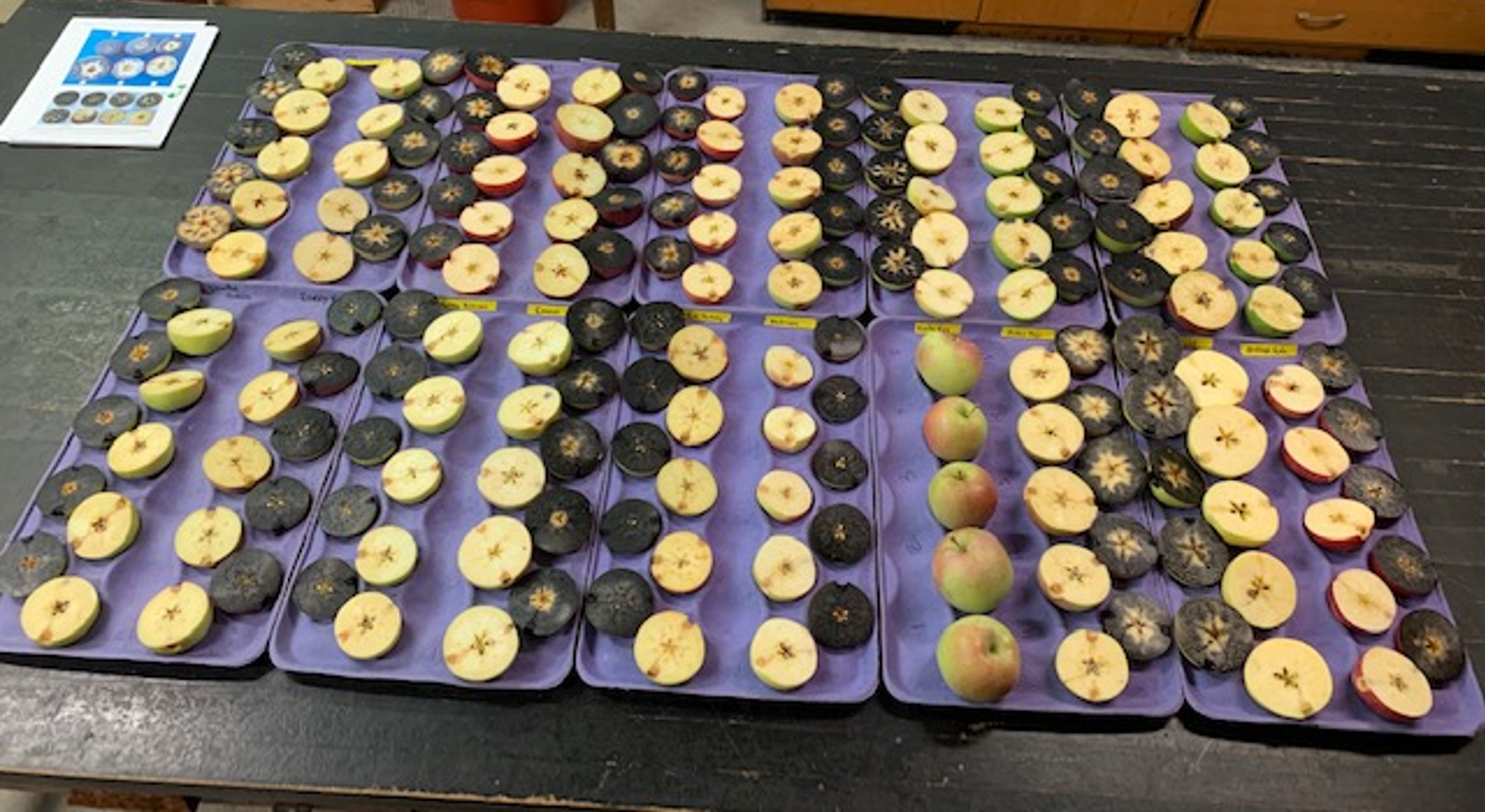
Sherif M. Sherif, Assistant Professor of Horticulture at Virginia Tech, School of Plant and Environmental Sciences, AHS Jr. Agricultural Research and Extension Center
595 Laurel Grove Road, Winchester, VA 22602
Tel. 540-232-6035, Email: ssherif@vt.edu